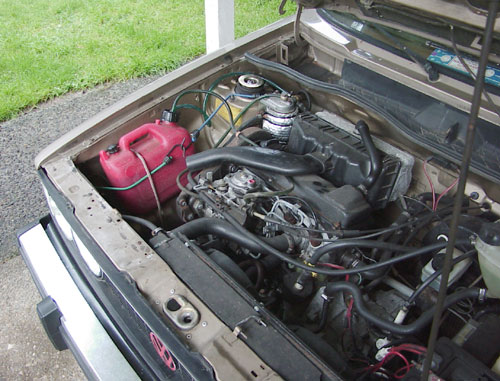Rabbit Running
I've been having problems with the fuel system on my diesel VW Rabbit. It started back when I winterized the fuel, switching from 100% biodiesel to a 60% biodiesel/40% petroleum diesel blend. Each fall, it's necessary to blend biodiesel with a percentage of regular pump diesel as an anti-gelling preventative.
I have noticed in past years, that my injection pump seals would leak a bit during the winter, then stop in the spring when I went back to straight biodiesel. My assumption was at the ULSD (Ultra Low Sulfur Diesel) that we are forced to buy at the pumps these days was causing my pump seals to shrink, resulting in the leaks.
This last fall, I noticed some leakage in the rear of the car, under the fuel tank. After a drive to the beach one nice day, I put the car away, only to find a large puddle of fuel under the car the next day, enough fuel it needed about half a bag of cat litter to soak it up. I decided to just not drive the car until I got that fixed.
Last month, I got invited to stay at my friend's beach house, and I didn't want to drive my pickup, so I investigated the leak a bit more. I found that the lines on the fuel tank were all spongy and obviously seeping fuel. Replacing the lines to the tank was going to be a big undertaking, one I didn't have time or energy for. After starting the engine, I saw a drip of fuel about every two minutes or so. "That's not so bad, I can deal with that" was my thought. So I stuffed rags all around the seeping lines, covered it with cardboard and secured it all with a few bungee cords for good measure. I thought I would just remove the somewhat soggy rags when I got home.
Wrong. After driving 80 miles, I arrived at the beach house and looked under the car. It looked like it had been raining fuel for miles and miles. I had to put cardboard down on the driveway to catch all the rain. Ick. And now I was going to have to drive all the way home again.
Driving home rewarded me with the back of the car being coated with a film of atomized fuel from the leaking, and the underside of the car was saturated. Crap.
In order to fix the leaky fuel lines, I was going to have to remove the fuel tank. This means also removing the exhaust system and the rear axle to enable the tank to drop down enough to reach the lines on the top of the tank. Another project I didn't have time for.
I decided to let the car sit some more.
We all know what fuel prices are doing. The community here has some of the lowest gas prices in the country (for whatever reason???), I paid $3.499 last week for regular. My pickup gets a fairly respectable 21 MPG (respectable for a 4x4 with 180,000 miles on it), but I want my 50 MPG econo-sports car back.
This afternoon, I found a compromise. I'm not thrilled about rolling around on wet concrete to change out the lines on the tank in winter weather, so I rigged up a temporary solution so that the car is driveable, and can be moved around, driven up ramps, etc when I do get around to doing the permanent repair:

Yes, that's a one-and-a-quarter-gallon gas can under the hood. I connected the suction line from the injection pump to a dip tube in the gas can and put the return line in as well. Now the car runs and drives without pissing fuel all over the road and itself.
Of course, now I have about a 60 mile range before I have to "fill up" again, but that's fine for the short term. This car used to have an auxiliary fuel tank, with a total capacity of 22 gallons, I could go 1,100 miles without stopping for fuel! It will be back there again, as soon as I get synthetic hoses and lines on the tank. A much better project for warmer weather.
Thank you freakin' federal govt for making the fuel my car runs on destructive to it's own fuel system!
Vegetable esters are very slippery molecules. Just look a the chemical compatibility charts for something as simple as protective work gloves and you'll see that there isn't much that stands up well to vegetable oil.
In anticipation of this, I changed out all of the flexible rubber hoses under the hood to synthetics, nylon and urethane, neither of which seem to be affected by biodiesel.
I'm sure that 8+ years of constant exposure to biodiesel had caused some degradation of the hoses at the tank, but it also doesn't escape my attention that I didn't have any problems until after a couple year's use of ULSD in the winter.
If it isn't storming this afternoon, I'll roll under the car and begin pulling stuff loose in preparation for the tank drop. I already pumped it dry after setting up the under-hood reservoir.
An aside: the urethane lines are very tough, difficult to cut even with pruning shears, but they don't stand up well to the wharf rats down at Winchester Bay:

Those are toothpick points sticking out of all of the holes that some damned rodent chewed in my fuel lines back in 2005 when I was visiting my sister at an RV park. Apparently, the hungry little bastards smelled the biodiesel and decided to help themselves to a meal. Took a couple hours of jury-rigging to get fuel where it needed to go and get the injection system bled so the car could start and I could drive home.
Original material ©1996-2025 Mr. Sharkey | All rights reserved
